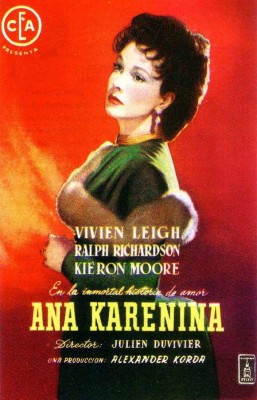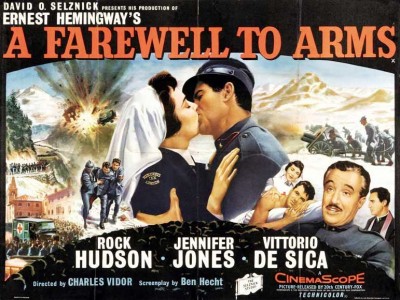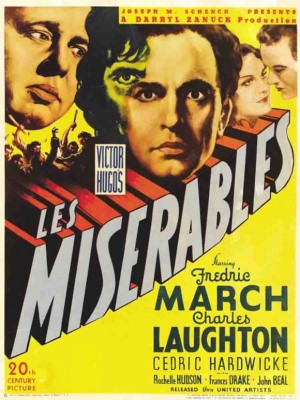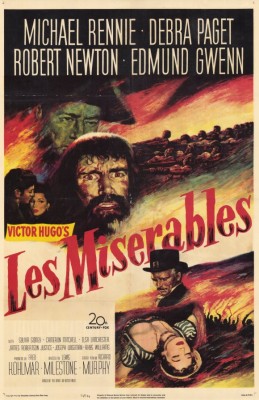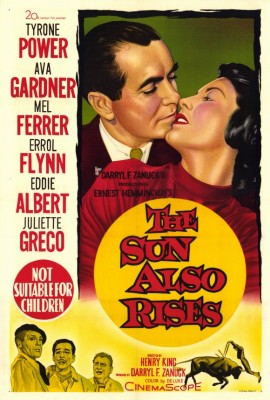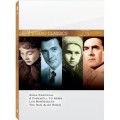| Reviews & Columns |
|
Reviews DVD TV on DVD Blu-ray 4K UHD International DVDs In Theaters Reviews by Studio Video Games Features Collector Series DVDs Easter Egg Database Interviews DVD Talk Radio Feature Articles Columns Anime Talk DVD Savant Horror DVDs The M.O.D. Squad Art House HD Talk Silent DVD
|
DVD Talk Forum |
|
|
| Resources |
|
DVD Price Search Customer Service #'s RCE Info Links |
|
Columns
|
|
|
20th Century-Fox Studio Classics - Anna Karenina / A Farewell to Arms / Les Misérables (1935 & 1952) / The Sun Also Rises
As I stated in my review of the boxed set containing An Affair to Remember/Leave Her to Heaven/A Letter to Three Wives/Peyton Place, the gradual decline of DVD has had at least one notable benefit for consumers. These recent Fox Home Entertainment quads, blatantly imitative of TCM/Warner Home Video's quadruple features, give film fans a lot of bang for their buck. With their RSPs of $19.98, that's less than $5 per DVD, less than what just one of these titles used to cost. This set represents an even greater value as it includes five titles instead of four: Anna Karenina (1948), A Farewell to Arms (1957), Les Misérables (both the 1935 and 1952 versions), and The Sun Also Rises (1957). Of the bunch really only one could be considered outstanding while the others are quite flawed adaptations, though all are interesting.
For the most part, these are the very same DVDs with the same abundance of extra features, often several hours worth per film: audio commentaries, original featurettes. If you've waited this long to start a classic film library, now's a good time to start.
Officially, these releases coincide with 20th Century-Fox's 75th Anniversary. (It's worth noting three of the five titles in this collection were really outside productions merely distributed by Fox and were not in-house productions at all.) Finding them at your local retailer or even on-line may not be easy, however. Under the title 20th Century-Fox Studio Classics - 75 Years they don't seem to be listed on Amazon, and good luck finding them at places like Best Buy, where employees consider There's Something About Mary a classic oldie. Addendum: Helpful readers on DVD Talk's discussion boards offer this link. Why this would be searchable under "Classic Quad" is anyone's guess.
Anna Karenina oozes with prestige. Made in England, it stars Vivien Leigh in the title role, Sir Ralph Richardson as Aleksei Karenin, and Kieron Moore as Count Vronsky, with a teenage Sally Ann Howes as Kitty Scherbatsky, Niall MacGinnis as Konstantin Levin, Michael Gough (yay!) as Nicholai, and Martita Hunt as Princess Betty Tversky. Lavishly produced by Alexander Korda, it was directed by Frenchmen Julien Duvivier, who like Leigh had recently returned to Europe after several fruitful if frustrating years in Hollywood.
As if to compensate for its very British cast and Continental-flavored direction, Cecil Beaton suffocates his actors with Russian-influenced costumes that look warm but often impractical. In retrospect it plays like a valiant but failed attempt, a more serious but ultimately less interesting work than the 1927 and 1935 MGM films starring Greta Garbo, and far outclassed by Aleksandr Zarkhi's 1967 Soviet-made epic, starring the great Russian actress Tatyana Samojlova (The Cranes Are Flying) who was born to play the part.
The film was made shortly after Leigh had suffered from much physical (tuberculosis) and psychological trauma (a nervous breakdown brought on by bipolar depression), some of it relating to a miscarriage she endured with husband Laurence Olivier. All this suffering is written on her face and comes through her performance, which benefits the second-half of the film but not the first, though Ralph Richardson, almost always superb in everything he does, keeps their characters' relationship grounded in a kind of emotional reality. In the end, though, the 1967 Soviet film remains the definitive version, rendering this not much more than an interesting curiosity. (*** 1/2 out of *****)
Extra Features: Featurettes: Tolstoy: The Man Behind Anna and The Tolstoy Legacy; still gallery.
The biggest and worst of the Hemingway adaptations produced during the author's lifetime, A Farewell to Arms is phony and overblown throughout, more like an attempt by producer David O. Selznick to recapture the magic of his greatest triumph, Gone with the Wind (1939). He originally hired the seemingly ideal John Huston to adapt the novel and direct the film, but he and Selznick didn't get along and the finished film credits Ben Hecht with the script and Charles Vidor with the direction.
As with all his later productions, Selznick turned A Farewell to Arms into a vehicle for his wife, the late Jennifer Jones, an unusual and talented beauty whom he frequently miscast, as he does here. Actually, Jones isn't too terrible as Catherine Barkely, the unaccented British Red Cross nurse, who in Italy during World War I falls in love with American ambulance driver Frederick Henry (Rock Hudson).
The bigger casting problem is, of course, Rock Hudson, a perfectly fine actor but all wrong as Henry. It's hard not to think of a stocky, Hemingway type in the role, especially when one considers that his 1929 novel was to a great degree autobiographical. Hudson, on the other hand, is conventionally handsome in the 1950s sense but not at all believable as an adventure-seeking writer and man's man.
Though filmed at many of the actual locations mentioned in the book, notably the Province of Udine and in the Italian Alps, with hundreds of costumed extras for its big battle scenes (impressive "money shots" abound), A Farewell to Arms pulls its punches, never once adequately conveying the war's unspeakable suffering in human terms. There are splashes of blood here and there, but it's all very much in 1957 Production Code terms. Despite the picturesque locations, despite the throngs of extras, it presents an unforgivably phony-looking war.
Selznick's attempts to create another Gone with the Wind-type epic only adds to this, his production shamelessly padding Hemingway's 300-plus-page novel with syrupy love scenes and even little splashes of broad comedy. Most painful are the film's opening titles, which unfold exactly in the style of Gone with the Wind, right down to the film's title literally sweeping across the screen horizontally in huge type, right-to-left. (** 1/2)
Extra Features: Trailer; Fox Movietone newsreel excerpts (three).
The 1935 version of Les Misérables is by far the best film of this set. I hadn't seen it before and it was something of a revelation. Probably because it was such a high-class, literary production it was able to use its obvious prestige to circumvent recently enacted Production Code rules. In any case the end result is an absolutely gripping, uncompromising account of early 19-century France's brutal, unforgiving judicial system. Extremely tense and humanistic throughout, it makes numerous small changes in adapting Victor Hugo's novel but remains true to its spirit.
The familiar story follows Jean Valjean (Frederic March), sentenced to 10 years of hard labor in the galleys for stealing a loaf of bread to feed a starving family, then hounded for years after by Inspector Émile Javert (Charles Laughton) after Valjean, branded an ex-con, breaks the terms of his release in trying to restart his life.
The picture is just superb in every respect with outstanding performances at its center. I thought I would prefer the 1952 Les Misérables because I couldn't see March, whose studied, actorly performances defined his '30s films, in the role of Jean Valjean, whereas British actor Michael Rennie (The Day the Earth Stood Still), Valjean in the remake, seemed perfectly cast.
Possibly inspired by Laughton's instinctive, proto-Actors Studio approach, March seems to have suppressed his usual legitimate stage-like theatrical mannerisms in favor of an extremely naturalistic performance that really reaches into the gut of this deeply conflicted character. Rennie, on the other hand, is exactly what I feared March might have been: emotionally aloof and mannered, exactly the wrong approach. The extreme bitterness comes through Rennie's performance, but much less so the humanism.
Opposite Rennie's as Inspector Javert is Robert Newton. To his credit, Newton is about as restrained as was possible for the hammy, alcoholic actor at this point, but it still lacks Laughton's mesmerizing subtlety. Where Javert actions might easily come off as psychotic pig-headedness, Laughton infuses the character with such a delicately expressed understanding that, like Valjean, he almost becomes sympathetic.
Both are first class productions, though the extremely good production design of the first film is so underemphasized that it convinces whereas the 1952 version all but invites its audience to "ooh" and "ahh" at its lavishness and it very much has the look of a pre-CinemaScope revolution '50s epic. 1935 Version: (*****). 1952 Version (***).
Extra Features: Featurette: The Fugitive and the Pursuer: Vidocq; trailer for the 1952 version; still gallery (both films).
The Sun Also Rises (1957), adapted from Hemingway's watershed 1926 novel about aimless expatriates living in Paris is adapted into a pretty aimless movie itself, but a masterpiece compared to A Farewell to Arms. Though reasonably faithful to Hemingway's story, with surprising frankness by 1950s standards - the main character is plainly identified as impotent, for instance - this overlong (130 minutes) film never quite catches fire, but its sincerity impresses.
On the plus side is its once-in-a-life cast: Tyrone Power, Ava Gardner, Errol Flynn, Mel Ferrer, and Eddie Albert. Flynn and Gardner come off especially well as glamorous and worldly but completely out of control drunks - a case of life imitating art. Also good is the film's superb CinemaScope lensing, most of it on location in Paris and in Mexico doubling for Spain.
As in the novel, the story is mainly a portrait of the cynical, high living but generally empty lives of various characters forever changed by the Great War. Paris-based journalist Jake Barnes (Power) is the main character, though the story primarily revolves around Brett Ashley (Gardner), an outwardly effervescent local personality who loves Jake but since he feels compelled to reject her (because of his impotence) goes through men like paper towels, including socially awkward Robert Cohn (Ferrer), heavy boozer Mike Campbell (Flynn) and, later in the film, rising star bullfighter Pedro Romero (Robert Evans, later the famed producer).
Visually, the film is quite lavish, and though a few 1950s-era automobiles can be seen here and there, the film does a remarkable job dressing up unspoiled neighborhoods in France and Spain to look as they did back in the 1920s, on a scale that, for a variety of reasons, would be almost impossible to do today without resorting to computers. The cinematography (by Leo Tover) and score (by Hugo Friedhofer) are excellent.
Mostly though, the film is worth watching for its cast. Gardner was then near the peak of her beauty, Power was peaking as an actor though aging rapidly, while Flynn is a near-total wreck, but fascinatingly so. Eddie Albert is fine as the American tourist eager to participate, gamely joining in the running of the bulls, for instance. Evans, conversely, is hilariously awful as Pedro. Maybe the kid shouldn't have stayed in the picture. (*** 1/2)
Extra Features: Audio commentary by Patricia King Hanson and Frank Thompson; The Old Men and the Bulls: The Making of 'The Sun Also Rises' and Hemingway on Film (two original featurettes); A Conversation with Director Henry King [Archival audio only]; trailer and still gallery.
Video & Audio
Though several films are preceded by dire warnings about transfer being made from the "best surviving" elements, everything looks great except for A Farewell to Arms, which is notably soft and lacking detail, though acceptable. That film and The Sun Also Rises are presented in their original CinemaScope aspect ratios with 16:9 enhancement, with impressive Dolby versions of their original four-track magnetic stereo soundtracks (with Farewell in 3.0 stereo and Sun in 4.0 stereo). Anna Karenina and the two Les Misérables are in their original full-frame black and white presentations with the 1952 remake looking the weakest, ironically enough. The 1935 version is derived at least in part from a television syndication version but it's still above average. Reportedly Anna Karenina was first released in a 139-minute cut but this release, just shy of 112 minutes, is the longest surviving version.
All four features include optional English, French and Spanish subtitles, except for A Farewell to Arms and The Sun Also Rises, which have French and Spanish mono audio tracks, but only English and Spanish subtitles.
The discs are all single-sided and dual-layered with the exception of Les Misérables, which is a flipper disc with one film per side.
Extra Features
See above.
Parting Thoughts
This is a real bargain even if you already own two of the five films included in this set. All five are worthwhile (though A Farewell to Arms only as a wannabe Gone with the Wind curiosity) and all include extra features. How can it miss? Highly Recommended.
Stuart Galbraith IV's latest audio commentary, for AnimEigo's Musashi Miyamoto DVD boxed set, is on sale now.
|
| Popular Reviews |
| Sponsored Links |
|
|
| Sponsored Links |
|
|
| Release List | Reviews | Shop | Newsletter | Forum | DVD Giveaways | Blu-Ray | Advertise |
|
Copyright 2024 DVDTalk.com All Rights Reserved. Legal Info, Privacy Policy, Terms of Use,
Manage Preferences,
Your Privacy Choices | |||||||









